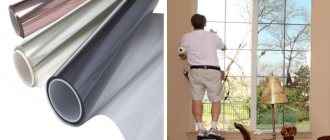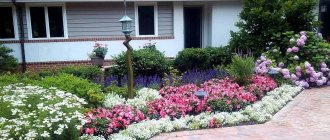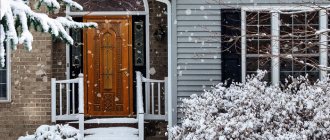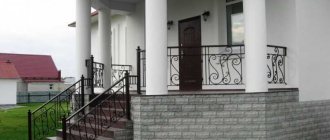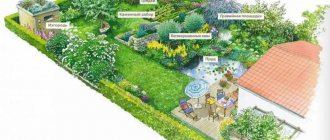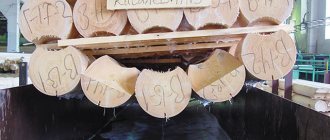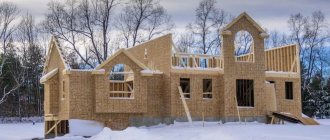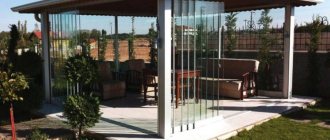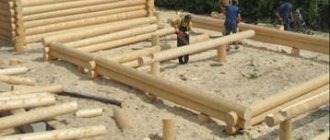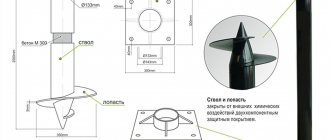In addition to beauty and ease of use, the outdoor porch of a house must be safe. Especially in winter, when the likelihood of slipping on level ground increases significantly. It will be useful for home owners to learn how to minimize the possibility of injury and what materials can be used to do this.
Rubber coverings for porch steps Source vsenasklade.ru
Rough coating with sand
The steps are varnished (it is also possible to use epoxy, acrylic glue, PVA emulsion). Then, until the product has dried, you need to sprinkle it with fine quartz sand, preferably colored sand. You can use stencils to create a design. When the base dries, the excess grains of sand must be swept away.
Another option is to paint the steps with oil paints, on which you also sprinkle sand.
If you want granite, be prepared for bush hammering
Granite porches are very durable, strong and look good. Only polished granite is what causes injuries. How to avoid this? There are several options for treating granite to make it safe.
Treatment can be carried out at high (+600 °C) temperatures.
PHOTO: i.ytimg.com This treatment destroys polishing, but gives a rough surface on which even thin pins will not slip.
This treatment costs approximately 700 rubles per 1 m2. Inexpensive compared to paying sick leave for the injured person.
There is another option - bush hammering, that is, processing the surface of a granite slab with a coarse-grain grinder.
PHOTO: For processing, they pass over the surface in stripes - and they get a completely non-slip coating
Finally, thin cuts can be made in granite into which rubber strips can be inserted. They prevent slipping.
PHOTO: If we are talking about porcelain stoneware, then notches are made on it for stability. And in addition, there are ready-made tiles with an abrasive strip on sale
Scope of use
Non-slip facing material has a wide range of applications. Most tiles are used indoors or under canopies, but there are also some that are perfect for use in open spaces.
Most often, non-slip ceramic tiles are needed for finishing:
- bathrooms and showers;
- hallways;
- balconies and terraces;
- summer kitchen premises.
Porcelain tiles have found application in cladding:
- hallways, corridors, balconies in apartments and houses;
- adjacent areas, staircases, ramps and patios;
- hospital and sanatorium premises;
- catering establishments;
- retail and utility areas in stores;
- office premises;
- hotel and entertainment complexes.
This type of cladding is also used in other areas (wherever it is necessary to observe increased safety measures or there is an increased risk of injury).
Tape overlays
Another effective option for quickly eliminating slippery spots on the porch is the use of anti-slip tape pads.
The most optimal for outdoor use is an anti-slip mat on the steps made of high-strength abrasives, which have increased wear resistance that can withstand more than one month of intense load. At the same time, they are resistant to temperature changes and are easy to attach, and therefore can be used with any type of porch covering - concrete, ceramics, wood, etc. To preserve porcelain stoneware and ensure safety, a metal profile is often attached to the steps. This profile provides more reliable grip and lasts longer than rubber products. But at the same time, a metal profile can ruin the appearance of the porch.
In the case where the porch is located indoors, you can use less rough anti-slip vinyl tapes, which, in addition to increased resistance to moisture, have improved tactile properties. We can say that this is an ideal solution for use in swimming pools, bathhouses and other wet areas.
The third type is luminescent strips, which not only make the porch safe, but also decorate it and additionally decorate the entrance to a restaurant, bar or other public establishment.
Abrasive tracks
Such anti-slip pads are made in the form of strips, tapes, tracks and adhesive-based mats. Rubber glue and abrasive particles are applied to the base polymer layer, which is why the coating acquires the desired properties. The abrasive is crumbs of various solid substances that have high strength, for example, granite.
Advice! To treat steps, it is most convenient to purchase a coating in the form of narrow self-adhesive strips. It is very easy to install, and its service life will be at least 3 years without the need for dismantling during the warm season.
Anti-slip abrasive tape Regart fr-Luxe
The cost of abrasive coatings is low, and they can only be used where the loads will not be too severe. With high traffic, the tapes will quickly peel off from the surface.
Anti-slip treatment for ceramic tiles
Ceramic tiles or porcelain tiles are one of the most slippery materials used in porch steps. In addition, the peculiarity of the structure, which consists in the use of different brands of porcelain stoneware for the interior and exterior decorative parts, does not allow the use of classical control methods based on the interaction of chemical reagents or the abrasive properties of sand or other bulk material. Therefore, if it is slippery on the street and the porcelain stoneware is covered with a layer of ice, you need to use anti-slip mats or similar devices, the installation of which will completely eliminate the danger of slipping.
The most common and durable anti-slip material is corrugated metal strips that are mounted on the steps. In this case, you can take thin overlays located along the entire length of the steps, as well as special corners, which, in addition to the anti-slip effect, allow you to preserve the most vulnerable places of the tile - the sharp corners of the steps.
Another option for anti-slip porch equipment is to install flexible rubber pads. With their relative cheapness and ease of installation, anti-slip rubber tapes not only provide reliable adhesion of the sole to the surface, but also effectively prevent the destruction of the porcelain stoneware itself. In addition, the shock-absorbing properties of rubber make walking on steps more comfortable.
The durability and versatility of rubber pads, which are typically made from recycled tire rubber, allows them to be used year-round, regardless of weather conditions or temperature.
Rugs
The easiest way to deal with slippery surfaces. Rubber mats come in different sizes. From small strips on each step to a covering that occupies a large area in front of the front door. Additionally, the products help get rid of dirt on shoes. But there are options when such a simple element can even act as decoration.
Decorative rubber mats for porch steps Source ca.news.yahoo.com
What to build an anti-slip porch from
During the construction phase, it is quite possible to build non-slip steps. To do this, you need to choose a material with a high coefficient of friction and low moisture absorption. Natural roughness will ensure the adhesion of the soles, and quickly draining water will not turn into ice.
Such non-slip coatings include:
Such coverings are good at the initial stage, when the porch is just being built. The tiles are easy to install on any surface (concrete, wood, metal) and last a long time.
What to do to prevent the porch and steps from slipping in winter
In what ways can you effectively and quickly solve the problem of slippery steps and porch stairs today? Especially in autumn and winter, when smooth surfaces become especially dangerous. Of course, this means the use of all kinds of anti-slip devices and coatings on slippery surfaces. There are several materials that can be used to cover a porch to prevent it from slipping. Let's look at the most common ones and find out their pros and cons.
1) Anti-slip self-adhesive tape. It is a polyester tape with a vinyl or abrasive coating. Attached with an adhesive coating on one side. Pros: simple, quick and reliable installation, good anti-slip performance, large selection of colors, low price. Cons: not durable (1.5 million passes, 3-5 years), requires a smooth surface.
2) Anti-slip self-adhesive strips (linings) and corners. They have a rubber base and are attached using an adhesive coating applied to the bottom of the material. Apply to slippery steps of stairs and porches. Pros: simple, quick and reliable installation, protect steps from chipping and abrasion, wide range of colors, low price. Cons: not significant protrusions at installation sites, requires a smooth surface.
3) Aluminum corners and profiles with rubber inserts. They have an aluminum base, which is attached to the base with dowels and screws, and have a removable rubber insert. When using such corners and profiles, slippery stairs will no longer be dangerous. Pros: reliable installation, durable, have easily replaceable, inexpensive rubber inserts. Cons: labor-intensive installation that requires care, minor protrusions at fastening points.
4) Anti-slip joint between tiles. It has a rubber base and is attached to the seams of tile coverings. Pros: reliable installation, aesthetic appearance, low price. Disadvantages: labor-intensive installation process, technological difficulties with repair and replacement of this material, cannot be repaired, protrusions on the surface of the coating.
5) Aluminum corners and tile trims with removable rubber inserts. They have an aluminum base into which an anti-slip rubber insert is inserted. They are attached between or under the tiles directly when laying them. A slippery porch will become quite safe when using these materials. Pros: reliable installation, easily replaceable rubber inserts, durable. Disadvantages: labor-intensive installation process, technological difficulties with repairing and replacing aluminum parts, minor protrusions on the surface at fastening points.
These types of anti-slip coatings can be mounted on concrete, metal, ceramic, marble, granite and even wooden porches. They are waterproof, heat-resistant and can be used both inside and outside buildings.
Rubber crumb coating will make the stairs safe and visually attractive.
Well, what should you do if none of the above listed anti-slip coatings suits you, due to insufficient coverage of the surface of the steps. In this case, steps, slabs and crumb rubber coatings will help you. These materials consist of recycled rubber tire crumbs and a polyurethane binder. They are attached using polyurethane glue and can completely cover the entire step. Entry from the street using such a surface will be the safest of all available types of anti-slip surfaces. Pros: reliable, easy installation, covers the entire step and protects it from chips and damage, durability, evenness of the coating, wide selection of colors, maintainability, safety from injuries. Cons: high price.
To buy the product you like, just call the numbers listed below or leave a request.
What to do to prevent the porch and steps from slipping in winter
What can be done to prevent the porch and stair steps from slipping in winter? What are the ways today that can effectively and quickly solve the problem of slippery steps and staircases? Especially in autumn and
Installation recommendations
All anti-slip coatings are secured with adhesive, screws, clamping strips, or have a ready-made adhesive base. In any case, first mark the stairs using a pencil or marker, mark lines for tapes, tiles, and corners. If necessary, make holes for fasteners (usually at a distance of 3.5–4 cm from each other).
Important! The easiest way to glue the coating is if it has an adhesive base: you just need to remove the protective layer and apply the material to a clean base.
An anti-slip coating on a wooden staircase is most often attached to polyurethane glue. For concrete steps, concrete self-tapping screws are used, and if they are ineffective, dowels are used, which prevent the hardware from jumping out of the groove.
Installation of anti-slip strips
If installed correctly, anti-slip materials will serve for many years and will bring real benefits to owners and guests.
Aluminum accessories
Combined linings with an anti-slip effect are made from aluminum profiles, which can be used on different surfaces. Inserts made of rubber or other material with the desired properties are attached to the profile, after which the structure is fixed on the step.
Also on sale are L-shaped aluminum profiles, which are used in places with increased mechanical loads. They cover not only the surface of the step, but also the riser. As the rubber part wears out, it can be replaced with a new one.
Standard corner anti-slip pad for step
Aluminum structures on the market are presented in the form of relief nets that are fixed to the porch. They have an additional dirt-repellent effect and help to quickly and easily clean the soles of shoes.
Important! For areas that are subject to heavy icing, aluminum coatings are not suitable, since in such conditions the anti-slip effect is reduced.
steps
In rare cases, you can see the entire flight span consisting of monolithic rubber. It is used on a porch that experiences significant loads. As for the rest, separate overlays are produced for the steps, which are glued to the tread.
Rubber molding fits perfectly with any surface, be it concrete, wood, iron or even asphalt. Of course, the material fits well on any facing tile. Often the product has a small bend that wraps around part of the riser.
Cover with a bend for the riser Source kiensx.tomadamsforcongress.com
How to cover the porch: an alternative solution
Well, what to do if none of the above listed anti-slip coatings suits you, due to not completely covering the surface of the steps? Undoubtedly, in this case steps, slabs, etc. will help you. As you know, these materials consist of recycled rubber tires and a polyurethane binder. By the way, they are attached with help and can completely cover the entire step. Perhaps, the entrance from the street using such a coating will be the safest of all available types of anti-slip coatings. Pros: reliable, easy installation, covers the entire step and protects it from chips and damage, durability, evenness of the coating, wide selection of colors, maintainability, safety from injuries. Cons: high price.
You might be interested in:
Typically, the most beautiful and durable porch materials are also the slipperiest. The most dangerous weather for such coatings is changeable weather - when water freezes abruptly without having time to dry and evaporate. On such days, steps become a headache for every owner, because on a slippery porch it is very easy to fall and get injured. This situation applies not only to private households, but also to children's and municipal institutions, shops and entertainment centers.
Anti-slip coating is what is designed to save people from injury. Today, there is a huge selection of porch materials that will make your steps both safe and beautiful.
Processing agents and traditional methods
There is far more than one way to make the steps completely safe for use, without in any way disturbing the external aesthetic appearance of the stairs. For this purpose use:
Synthetic fluids
Anti-slip liquid
The main principle of operation of these products is the creation of a silicon layer of several microns, providing the necessary roughness. The advantage of using synthetic fluids is their versatility, which allows you to use an anti-slip agent on almost any type of staircase surface. The disadvantages include a somewhat high price.
Coarse sand
An inexpensive and unpretentious shelter option that is suitable even for already frozen steps is ordinary coarse sand. Its main drawback is that it can remain on shoes, so it quickly pollutes the room. On the other hand, sand quickly wears off and is blown away by the wind from the surface, and therefore requires constant updating of the coating.
Towels
An old towel placed on a step will quickly freeze to the ice. Once on the step, the towel instantly turns into a tread strip. This is a great option when your steps are covered in ice and you don't want to waste time trying to melt or chip it off.
Cat litter
Like towels, cat litter and coarse sand provide instant traction in icy conditions. Simply place a layer of cat litter on top of the ice. Kitty litter and sand are natural products that biodegrade, so it's also environmentally friendly.
Magnesium chloride deicer
The best deicer for exterior steps is magnesium chloride. It melts ice down to -10°C, does not corrode metal, does not rot wood or destroy concrete, and is safe for pets and plants.
Salt
Salt is one of the most popular and effective methods of de-icing, but in addition to dissolving the ice, it has an extremely negative effect on shoes, leaving behind white streaks that are difficult to remove and destroying the outer coating, which reduces the service life of the stairs.
Please note that the use of rock salt may cause corrosion of concrete! It is also poisonous to plants that may grow near stairs. In addition, salt is ineffective at low temperatures.
Water and alcohol
Another universal anti-slip agent for covering stairs is a mixture of alcohol, water and any dishwashing detergent. By dissolving 100 grams of alcohol in two liters of water and adding a little degreaser (about ten drops), you will get an effective remedy for combating already formed ice. For practical use, it can be poured into bottles, from which you can then water the stairs if necessary. The advantage of this solution is that the ice will not only become non-slip, but will also completely disappear from the surface, eliminating the need for mechanical cleaning.
Anti-slip pads for outdoor stairs
Street stairs covered with smooth stone and lined with uncoated polished ceramic tiles become especially dangerous in icy conditions.
In an open space outside, frozen water on the steps can become a threat to life.
It is necessary to equip and use rubber or PVC linings as a covering for stairs in a timely manner.
Such pads are made of elastic materials that have shock absorption properties.
Due to the high degree of adhesion of the surface to the sole of the shoe, an accidental fall from the steps is unlikely.
There are openwork and cellular products on sale that help keep your home clean.
Fallen leaves, small stones and sand on the soles of dirty shoes will get stuck in the recesses of the protective coating.
Fixing the overlays on the steps of the stairs occurs in different ways:
- self-tapping screws with dowels
- glue
- self-adhesive backing
Durable outdoor linings are resistant to air temperature fluctuations in the range from - 40 degrees to + 50 degrees C.
The length of such overlays is 75 - 120 cm.
The width is 25 - 30cm.
The modern building materials market offers a wide range of rubber linings with corrugated stripes.
They are very comfortable and functional.
The relief of these stripes significantly increases the stability of steps when walking on stairs and cleans shoes well of dirt.
But not suitable for lovers of high heels.
Thin pins getting stuck in the slots of the strips can have the opposite effect and cause a fall. Take care of yourself!
Rubber materials
To produce the most popular anti-slip coatings, crumb rubber is used, which is obtained by recycling old car tires. Particles of a certain fraction (usually less than 10 mm) are selected from the raw material, polyurethane and dyes are added.
Rubber crumb coating
From the finished mass, different versions of materials with anti-slip properties are made, which are widely used:
- on the steps of private houses;
- next to garages, outbuildings;
- on the territory of administrative buildings;
- on children's playgrounds;
- in sports organizations;
- at the entrances to educational institutions and shops.
In addition to porous coatings made from crumb rubber, materials based on vulcanized rubber are also produced. They are completely homogeneous, homogeneous, used in their original form or in combination with metal profiles.
Rubber coverings ensure human safety when entering a house and are ideal for lining steps. They have many advantages:
- have a long service life - up to 50 years;
- resist friction, mechanical stress, shock;
- elastic, not subject to cracking and brittleness even in severe frost;
- tolerate temperature changes within -40...+70 degrees;
- protect the base material (for example, tiles) from impacts and deformations;
- comfortable when walking, thanks to excellent shock-absorbing ability;
- do not deteriorate from the action of chemicals - solvents, salts, alkalis;
- do not become a breeding ground for fungi and mold;
- when wet, they do not lose their anti-slip properties and do not allow ice to form;
- suitable for outdoor and indoor use;
- easy to install and combine with other materials;
- are sold in a wide range, in different shades.
Such coatings also have disadvantages.
Important! All of them have poor combustion resistance, and after ignition they release many harmful components into the atmosphere, therefore they require compliance with fire safety measures. The price of some coatings is quite high.
Rugs and seamless flooring
Rugs are the simplest and cheapest option for arranging safe steps on the porch. They can have different sizes. There is always the opportunity to choose the right product.
Some rugs resemble narrow strips and are placed only on the steps. Others - large in width and length - are suitable for covering the area in front of the front door.
Rubber mats can also be produced in the form of a roll covering up to 125 cm wide, with a thickness of 6–13 mm. This material can completely cover the steps of even the largest staircase.
Anti-slip flooring rolls
The roll anti-slip coating on the steps is secured with metal pads located at the bottom of the riser.
Advice! In order to save money, you can cut out separate pieces from it and glue it only to the steps.
Seamless rubber coatings are monolithic. They are applied manually or by spraying using expensive equipment. Typically, cladding made from such material is used where significant loads are regularly placed on the porch.
Seamless anti-slip coating
Thin anti-slip strips
Such products are often mounted on steps decorated with slippery tiles. They use aluminum as a rigid base, so fixation is possible even in areas subject to high loads.
Planks and moldings fit perfectly with any other surface - concrete, wood, metal, asphalt. They usually have a slight bend that wraps around part of the riser. The planks can be smooth or textured.
Important! The latter enhance the anti-slip effect and are additionally used to clean dirt from shoes.
Crumb rubber pads
In order not to hide the beauty of the steps, especially if they are decorated with expensive stone, you can treat only the edges or corners with rubber. This is enough to reduce the risk of injury on the porch.
Corner and linear overlays are made from crumb rubber. They are inexpensive, easily attached to self-tapping screws or glued to the surface of the steps.
Rubber tiles
This coating is very popular and is used not only on the porch, but also on the floor in garages and outbuildings. Modular tiles are also used to decorate the area around swimming pools, as well as paths and areas around the house - special rubber paving stones are produced for this purpose.
The tiles have dimensions similar to regular tiles and a thickness ranging from 10-45 mm. The thinnest material is used to decorate the porch.
How to punish an institution with a slippery porch
By the way, a slippery porch is not just a status symbol for an institution, but also a disrespect for visitors, for which you should be punished if you get hurt. In this case, the owner of the building is responsible for the injury, and you may be able to claim damages from him. So don’t endure the pain of a fall - call an ambulance right there so that the medical staff will record the scene of the accident.
PHOTO: It happens that you still got home after a fall and only then went to the doctor - be sure to report the scene of the incident, or even better, get eyewitness accounts
And then collect receipts - from medications and physical procedures to sanatorium treatment - in order to go to court for compensation. And keep in mind: the organization responsible for the incident must pay for your sick leave.
But if the porch belongs to you, look at how to avoid conflict and wasteful expenses.
Floor tiles
Special types of ceramic tiles also provide an anti-slip effect, which is why they are often used to cover porch steps in private homes.
Porcelain tiles
Anti-slip porcelain stoneware is a popular finishing material for decorating stairs, sidewalks, paths, and local areas. Its distinctive feature is the presence of a rough, loose surface with a protruding pattern, which has excellent grip on the sole of the shoe.
Porcelain tiles are not subjected to grinding and polishing; depressions, grooves, and potholes remain on it. A relief material with stripes and geometric shapes on the surface is also produced, which is cast in special molds.
Steps for porch made of porcelain stoneware
Porcelain tiles have excellent performance characteristics:
- durability;
- resistance to loads and abrasion;
- resistance to aggressive chemistry;
- moisture resistance;
- low water absorption;
- resistance to destruction from thermal shock.
If you decide to clad the steps of the porch with porcelain stoneware, it is recommended to additionally use a embedded profile. This element is placed on the extreme sections of the steps, which increases the anti-slip effect of the tiles.
Also, a special composition can be applied to the surface of porcelain stoneware, changing the structure of its surface. Such products partially dissolve silicon dioxide in the top layer of the slabs, thereby increasing their roughness.
Clinker tiles
Clinker, or clinker tiles, is made by firing clay under special conditions. It has high density, strength, frost resistance and excellent anti-slip properties. All of these qualities make the tile suitable for covering steps on street stairs, porches, and for decorating terraces, patios, and balconies.
Advice! When selecting a material, it is important to pay attention to the roughness index - it should be in the range from R9 to R13.
Clinker step
Finally
A wooden porch is a symbol of coziness, home warmth, comfort, and peace. Wood is easier to process. Even an inexperienced craftsman, knowing how to use a saw and a hammer, can make a porch for a country house in a few days. Wood allows you to diversify the shape of the threshold, railings, and balustrades.
This is possible if you take a responsible approach to the question of how to paint a wooden porch on the street. You will simultaneously solve problems with both design and protection from rot, mold, bugs, and garden pests. Savings are inappropriate here.
Do not deny yourself the pleasure of living comfortably in a country house. All that is needed for this is to paint the porch boards in a timely manner, protecting them from premature wear and destruction.
